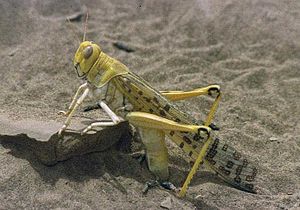Desert locust facts for kids
Quick facts for kids Desert locust |
|
|---|---|
 |
|
| A migratory phase adult laying eggs | |
| Conservation status | |
| Scientific classification | |
| Genus: |
Schistocerca
|
| Species: |
gregaria
|
| Synonyms | |
|
|
The desert locust (Schistocerca gregaria) is a type of locust. These insects can cause huge problems for farms in Africa, the Middle East, and Asia. They have been doing this for hundreds of years. About one-tenth of all the people in the world could be affected by these hungry insects. Big groups of locusts, called swarms, do not appear every year. They only form when the weather and other conditions are just right.
The desert locust is one of the most dangerous locust pests. This is because its swarms can fly very fast over long distances. A single locust can have two to five generations of offspring in one year. For example, a major outbreak in 2004–05 caused many crops to be lost in West Africa. This led to less food for people in that area. While desert locusts alone do not cause famines, they can make food shortages much worse.
How Desert Locusts Grow
Desert locusts do not go through a complete change like butterflies. Instead, their young grow in stages. These young stages are called "instars." As they get older, they are called "nymphs" or "hoppers." There are two main types of hoppers: solitary and gregarious.
When hoppers are in the solitary phase, they do not gather together. They move around by themselves. Their color often matches their surroundings, like green or brown plants. This helps them hide.
In the gregarious phase, hoppers group together. As they get older, their colors become very bright. They have black marks on a yellow background. Young adult locusts are pink. Fully grown adults are bright yellow. These yellow adults fly during the day in large, dense swarms.
The change from a single insect to a hungry swarm often happens after a drought. When rain finally falls, plants grow quickly in the desert locust breeding areas. The number of locusts then grows very fast. This means there is less food for each insect.
As hoppers become more crowded, their back legs start to bump into each other. This physical contact causes many changes inside their bodies. These changes make the insects switch from the solitary to the gregarious phase. When hoppers become gregarious, their color changes. They go from mostly green to yellow and black. Adult locusts change from brown to pink (when young) or yellow (when fully grown). Their bodies also become shorter. They release a special chemical called a pheromone. This pheromone makes them attracted to each other, which helps them form swarms.
Images for kids
-
A dense group of young hoppers in Sudan
See also
 In Spanish: Langosta del desierto para niños
In Spanish: Langosta del desierto para niños





